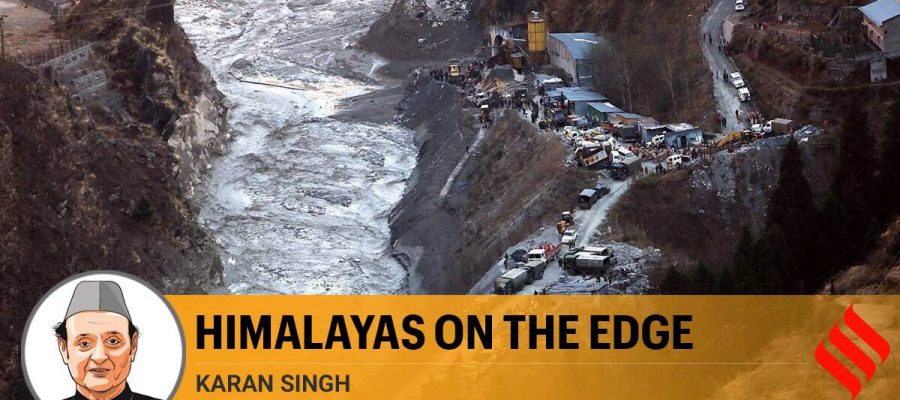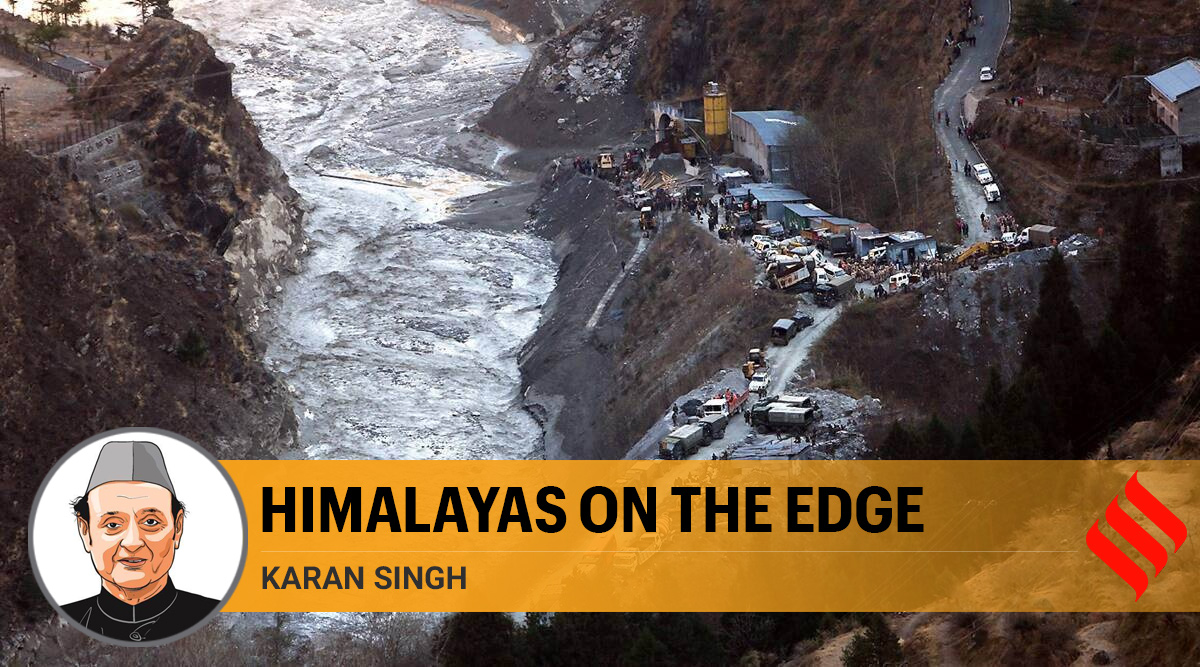The Himalayas are a divine entity. Let us not forget that its presiding deity, Lord Shiva, can be both benign and destructive.
The glorious Himalayas have always been a powerful presence in our cultural, economic and political life. In the opening verse of Kumarasambhavam, Kalidasa describes it as devatatma, a great spiritual presence. Indeed, it is from the Himalayan ashrams that the Vedas, Upanishads and many other seminal texts have come down to us. It is also the source of the great rivers that irrigate our country and feed half a billion people. Powerful though the Himalayas are, the Himalayan ecosystem is fragile and vulnerable. The constant damming of rivers has not only polluted the Ganga itself, but has also gravely jeopardised the people living in the higher reaches. Despite constant warnings from scientists and concerned citizens, the blasting of roads and damming of rivers continues unabated. The Kedarnath tragedy in 2013 claimed thousands of lives and the recent Rishi Ganga-Dhauli Ganga flood fury has also caused massive damage.
This unprecedented event of a flash flood in a calm, winter river on a bright sunny day is a strong warning from nature to make appropriate amends. It is common knowledge that winter is the time for glaciers to compact themselves and increase their girth rather than breaching or breaking and becoming the cause of deluge and disaster. If we continue the persistent interference in the sensitive Himalayan terrain for fulfilling a short-sighted concept of development, then we may have nothing left of the great Ganga basin to pass on to the next generation.
In 2008, G D Agarwal went on a fast-unto-death to protest the degradation of the Ganga due to hydro-power projects. After his death, the government found merit in his demands. It cancelled three under-construction hydro-power projects in the Bhagirathi Valley and declared the entire area as an eco-sensitive zone.
In the same year, a Planning Commission task force headed by G B Mukherjee highlighted the sensitivity of the Himalayan region (IHR), recommended demarcation of no-go areas and advised strategic environment impact assessments (SEA) in place of routine project-based environment impact assessment (EIA). Subsequently, Parliament debated the issue under Rule 193. An all-party delegation met then Prime Minister Manmohan Singh and requested cancellation of all hydropower projects on the Ganga. Consequently, an inter-ministerial group (IMG) was formed to analyse the extent of damage. In April 2013, this IMG submitted a report stating that the Ganga basin rivers suffer immense fragmentation due to hydropower projects and recommended that seven tributaries of the Ganga, including the Rishi Ganga, be left untouched.
Two months later, the 2013 Kedarnath tragedy took place and the then leader of opposition, Sushma Swaraj, suggested cancellation of all dams on the Ganga and rehabilitation of the Dhari Devi temple which was submerged in a hydropower project. About the same time, the Supreme Court took suo motu cognisance of the mushrooming of hydropower projects in Uttarakhand. A committee headed by Ravi Chopra was devised to investigate the role of hydropower projects in the wake of the disaster of 2013. Citing this report and several others, the Ministry of Environment and Forests stated before the court that the existing and under-construction hydropower projects had, in fact, played a direct and indirect role in escalating the impact of the disaster of 2013. The affidavit elaborated on the indirect impact of dams with regard to mass-scale deforestation, loss of water sources, fragmentation of river length, soil loss and so on, and the direct impact in terms of obstruction of the flow of raging rivers, thereby enhancing the flood fury downstream. It is appalling that the governments have not taken a decision on hydropower projects in the Ganga basin even after these findings. The promise of Ganga rejuvenation will be left unfulfilled if these dams are continued.
There are several infrastructure development activities happening simultaneously in Uttarakhand, which is already facing the furious consequences of climate change. Whether it is road-widening in the Chardham pariyojana, the hydropower projects, the ambitious Chardham railway project, unregulated tourism, building of resorts and so on, the cumulative impact of these activities combined with existing problems of forest fires, soil erosion and landslide prone hills, severely weaken the already fragile ecology.
An immediate regulation of all activities is urgently needed. A green cover in the adjacent valleys of the glaciers is essential, which will work as a buffer and minimise the impact of climate change. A 2018 Niti Aayog report cautioned that almost 60 per cent of water sources in the Indian Himalayan region are on the verge of drying up. For this reason, too, it is essential to maintain a green cover in the Himalayas. For this, the upper stretch of Himalayan valleys should be declared an eco-sensitive zone (ESZ).
A truly sustainable Himalayan policy is possible only when the cultural significance of the Himalayas and the Ganga is kept in mind. In this process, the contribution and support of concerned state governments is essential. Jammu and Kashmir, Himachal Pradesh, Uttarakhand, Sikkim and West Bengal (Darjeeling) fall within the immediate presence of the Himalayas, not to speak of the North Eastern States, which have their own set of environmental problems. This is an area where a creative federalism will be required if we are to meet the grave threats that loom ahead.
The Himalayas are a divine entity. Let us not forget that its presiding deity, Lord Shiva, can be both benign and destructive. When he dances his ananda tandava, the whole ecosystem fills with power and beauty, while if he does the vinasha tandava, there is total destruction. Let us work and pray for the former.
This article first appeared in the print edition on February 19, 2021 under the title ‘Himalayas on the edge’. The writer is a former Union minister.
Source: Read Full Article


